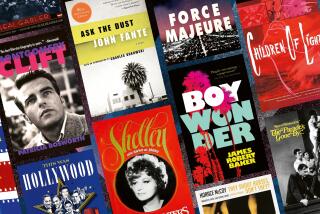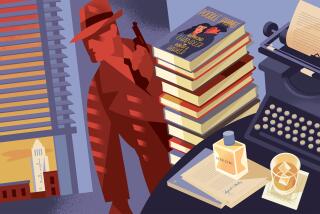Inside Howard Hughes : Two Authors Offer an Up Close and Personal Look at the Billionaire Aviator and Businessman
When veteran entertainment journalists Pat Broeske and Peter Harry Brown teamed up in 1991 to write celebrity biographies, they drew up a list of eight likely subjects before settling on a legendary ‘50s-era glamour queen.
But after a month of gathering preliminary research material, Broeske received a call from Brown at her home in Santa Ana. Brown had just completed his best-selling biography of another legendary glamour queen, “Marilyn: The Last Take,” and, Broeske recalls, “he just couldn’t do another book about dresses and gowns and hair and makeup. He said, ‘I want to do No. 2 on our list.’ My heart just went flip-flop.”
No. 2 on their list was Howard Hughes.
It’s one thing to sit at a dining room table reeling off potential candidates for a biography, Broeske says. But to tackle a book about a man whose life story encompasses business, aviation, motion pictures, the development of Las Vegas, political power-brokering and bizarre final years spent evading government and public scrutiny suddenly seemed far too daunting to Broeske.
“Somehow I wasn’t primed for it,” she says. “I immediately got into my car and drove to the Spruce Goose.”
Walking under the massive dome that housed Hughes’ famed “flying boat” in Long Beach, Broeske watched newsreel footage of the tall and lanky Hughes--looking dashing in an aviator jacket and boots after a record-setting flight in the 1930s and then debonair in a tuxedo as he squired a bevy of Hollywood’s most glamorous leading ladies.
“I realized he was a terrifically sexy figure,” says Broeske, 44. “I thought, ‘Oh, that’s Howard Hughes. We can do it.’ I realized his power, his glamour. We weren’t just doing an American tycoon. We were doing the most glamorous of American tycoons.”
Brown and Broeske’s “Howard Hughes: The Untold Story” (Dutton, 1996)--the result of 3 1/2 years of research and more than 600 interviews--trains the spotlight on little known and underreported aspects of Hughes’ life: his family relationships, his deteriorating mental condition and, most candidly, his women.
At least 17 other books have been written about the fabled billionaire, Broeske says, “but ours is the first one that really gets into his personal life.”
Among the authors’ revelations:
* Hughes had an emotionally incestuous relationship with his possessive Houston socialite mother, who handed down her germ obsession to her only child and compulsively checked her son’s naked body, temperature and bowel movements for any signs of illness.
* Hughes’ strange behavior in his later years was caused primarily by obsessive-compulsive disorder, a condition that today can be treated with Prozac and other drugs. Hughes once repeated the same sentence 33 times and spent five months in a tiny screening room, refusing to leave and instructing his aides not to speak to him unless spoken to.
* Hughes’ deteriorating mental state was exacerbated by a number of severe head injuries resulting from 14 plane and car crashes--and the painkilling drugs he began taking after a fiery 1946 plane crash in Beverly Hills.
His mental state also was affected by a 40-year bout with neurosyphilis. Hughes underwent a painful penicillin treatment for syphilis in the ‘30s and, the authors say, the syphilis recurred neurologically, leading to dementia.
*
Then there are the women in the life of a man the authors say was incapable of remaining faithful.
Beginning with his lengthy affair with movie star Billie Dove--begun shortly after Hughes and his Houston debutante bride Ella Rice arrived in Hollywood in 1925--Hughes cut a sexual swath through the film capital that surpassed any of the silver screen’s most legendary leading men.
There was his six-year, on-and-off romance with Katharine Hepburn. And major romances with Ginger Rogers, Lana Turner, Rita Hayworth, Ava Gardner, Yvonne DeCarlo, Jane Greer, Kathryn Grayson and Linda Darnell before his 1957 marriage to Jean Peters, his second wife.
And the “flings” with Bette Davis, Marilyn Monroe, Gene Tierney and literally hundreds of starlets, debutantes, models and beauty queens.
To tell Hughes’ story, Broeske and Brown tapped nearly 400,000 pages of recently unsealed court documents and depositions from the Hughes probate case, more than 2,000 pages of previously secret FBI files and documents from Hughes’ own offices, including his surveillance reports of the many women in his life during the ‘50s.
Only now has the tide of paper begun to recede. Broeske is in the process of shifting her Hughes files into plastic storage bins, Howard Hughes giving way to Broeske and Brown’s new biographical subject: Elvis Presley.
“It’s the great transition,” she says with a laugh.
Broeske has already spent several weeks doing Presley research in Memphis and Tupelo, Miss. The Presley book is due out from Dutton next year, the 20th anniversary of Presley’s death.
Broeske, a regular contributor to Entertainment Weekly and a former staff writer for the Los Angeles Times and segment producer for Fox TV News, says that “Howard Hughes: The Untold Story” will restore the image of the enigmatic billionaire.
When Hughes died of kidney failure in 1976, Broeske says, the image depicted in the media “was the 93-pound Howard Hughes with hypodermic needles broken off in his arm, unkempt hair and decaying teeth. That image persisted for a long time, and it’s hard to believe he once was tall, dark and handsome.”
That latter-day Hughes surfaces in their book only at the end, Broeske says, “because for most of his life, Hughes wasn’t that person.”
Broeske says the timing was right for writing a Hughes biography.
“For some reason, many people were willing to tell their secrets,” she says. “I don’t know if it was because they were getting on in years. We let everyone know we considered this a revisionist book on Howard Hughes.”
That may explain why former Hughes lovers such as Rogers agreed to answer the authors’ questions. After a couple of brief phone interviews, Rogers, who was in ill health the last year of her life, made a tape recording of her answers for the authors.
Among the numerous people they spoke to about the Hughes-Hepburn romance was former actress Phyllis Brooks, Cary Grant’s fiancee in the 1930s. Grant, who introduced Hughes to Hepburn, was one of Hughes’ best friends.
“I just called her cold,” says Broeske. “She was elderly but in a mood to talk when I found her. She says, ‘Oh, I want to tell you about Cary and Howard.’ She and Cary used to double date with Howard and Hepburn.”
Broeske says that despite rumors and a previously published account of an alleged homosexual relationship between Hughes and Grant, after 600 interviews and access to the FBI files on Hughes, she and Brown found no such evidence.
*
Many biographies require what Broeske calls a core interview: a prominent figure in the subject’s life who is willing to talk and who opens the door to others.
In the case of Hughes, it was Jane Russell, the star of Hughes’ famous ‘40s exploitation western “The Outlaw.”
“The reason we needed her is because, aside from Jean Harlow, she is Hughes’ most famous discovery,” says Broeske, adding that Russell was one of the few leading actresses able to keep Hughes at arm’s length sexually.
Broeske believes Russell “tested” her and Brown before agreeing to speak to them: When they approached her, she directed them to several other former Hughes friends.
After the writers interviewed one of them, Russell called Broeske at home and invited her and Brown to her home in Montecito, Calif. And, Russell said, bring your suitcases: They would be her house guests for a few days.
Russell gave the authors full access to six hours of documentary interview footage that Russell’s brother, a former Hughes Aircraft employee, has compiled of former Hughes associates, many of whom are now deceased.
The authors also tracked down Jeff Chouinard, the private detective who went on Hughes’ payroll in the ‘40s and became head of Hughes’ private security force. Chouinard was also in charge of Hughes’ surveillance in the ‘50s, a time, Broeske says, when Hughes had the equivalent of a modern-day harem.
“It was just this incredible girl-finding operation,” she says.
Hughes would scan magazines looking for pretty women and send talent scouts to car shows and beauty contests. The women would be photographed, and if they passed muster with Hughes, they’d be brought out to Hollywood.
The women would be set up in hotel rooms and apartment buildings around town and undergo a daily regimen of acting and singing lessons. But only a few were given small roles in films.
They were, Broeske says, little more than ornamentation for Hughes’ life.
Hughes would have lengthy phone conversations with some of the women. “It would be a form of courtship,” says Broeske. “Eventually, he’d show up, and some of the ladies had relationships with him. Some did not. And some just hated him.”
Chouinard and his men were assigned to watch these women and keep them under control. “Hughes didn’t want them dating other men. Some would climb out windows, and Jeff would chase them,” says Broeske.
In the end, however, Broeske came away liking Hughes.
“I think he was a real American original, sadly misunderstood,” she says. “He was sort of at his zenith in the ‘40s. But with his mental problems, he couldn’t continue moving forward. He began a retreat.”
More to Read
Sign up for our Book Club newsletter
Get the latest news, events and more from the Los Angeles Times Book Club, and help us get L.A. reading and talking.
You may occasionally receive promotional content from the Los Angeles Times.








